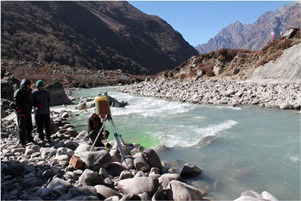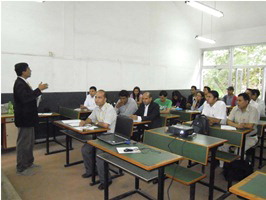Cycle 1 (2011 Deadline) Establishing a collaborative assessment of the impacts of climate change on the hydrological regime of the Langtang River Basin, central Nepal PI: Rijan Bhakta Kayastha, Kathmandu University U.S. Partner: Mark W. Williams, University of Colorado Project Dates: May 2012 - November 2014 Project Overview The Himalayas display great climatic variability, with the mountains acting as a barrier to atmospheric circulation for both the summer monsoon and winter westerlies. A substantial amount of the annual precipitation falls as snow, particularly at high altitudes, feeding the Himalayan glaciers. While about one-third of the world’s population depends to some degree on freshwater within the High Asia hydrological system, there is not enough data at present on river and stream flows, precipitation, and the contribution of seasonal snow and glacier melt to paint an accurate picture of the water resources there. The High Asia mountains funnel water into such major river basins as the Ganges, Brahmaputra, Indus, Amu Darya, and Syr Darya. The contribution of glacier melt to the major rivers in the region is unknown, with estimates ranging from 2 to 50 percent. Climate change is currently taking place and is projected to compound the pressure on natural resources and the environment associated with rapid urbanization, industrialization, population growth, and economic development. It will potentially have profound and widespread effects on the availability of and access to water resources.
This project focused on the hydrological regime of the Langtang River Basin in Nepal, including data analysis and field measurements of discharge, glacio-hydrological modeling, and estimation of future water availability in the river basin. The project team verified their modeling results using geochemical and water isotope tracer techniques studies developed by the National Science Foundation-funded Niwot Ridge Long-Term Ecological Research project, which allow researchers to follow water as it courses through mountain landscapes.
Final Summary of Project Activities During field visits to the Langtang River basin, the research team collecting water samples from the river to be filtered for sediment load analysis, collected water samples from the Lirung Glacier and Khimsung Glaciers to compare their hydrochemistry, and collected river water samples from different sections from Kyanjing to Syaphrubesi to find the altitudinal variation of different physico-chemical parameters. The researchers used the Positive Degree Day (PDD) model to compute daily discharge of Langtang River basin for the period 2015 – 2050 using the Regional Climate Model (RCM) Weather Research and Forecasting (WRF) data for RCP 4.5 and the change in glacier area, which was obtained from the study done by International Centre for Integrated Mountain Development (ICIMOD). The research team made several technical poster presentations at the International Symposium on Glaciology in High Mountain Asia and International Conference on Forests, Soil and Rural Livelihoods in a Changing Climate in Dhulikhel, Kavre, Nepal. A member of the research team, Anisha Tuladhar, won the award for best poster with her presentation of “Hydro-Chemical Analysis of the Langtang River, Langtang Valley, Rasuwa District, Nepal.” Two Master’s students received scholarships under the PEER award. The research team organized a training for glacio-hydrological modeling along with their annual meeting, where fourteen students, including four women, from different institutions of Nepal participated. At the time the project ended, the team also planned to release software to estimate discharge from a glacierized river basin, which was to be made available to educational institutions free of cost for academic purposes.
PublicationsRijan Bhakta Kayastha and Ahuti Shrestha. 2019. Snow and Ice Melt Contribution in the Daily Discharge of Langtang and Modi Rivers, Nepal. Chapter in the book Environmental Change in the Himalayan Region. https://doi.org/10.1007/978-3-030-03362-0_1 Aastha Chhetri, Rijan B. Kayastha, and Ahuti Shrestha. 2016. Assessment of Sediment Load of Langtang River in Rasuwa District, Nepal. Journal of Water Resource and Protection, 2016, 8, 84-92. http://dx.doi.org/10.4236/jwarp.2016.81007Anisha Tuladhar, Rijan Bhakta Kayastha, Smriti Gurung, and Ahuti Shrestha. 2015. Hydro-Chemical Characterization of Glacial Melt Waters Draining from Langtang Valley, Nepal. J ournal of Water Resource and Protection, 2015, 7, 605-613. http://dx.doi.org/10.4236/jwarp.2015.78049 
|  | | Tracer injecting in Langtang River during discharge measuring field visit (Photo courtesy Rijan Kayastha). | Inaugural workshop at Kathmandu University (Photo courtesy Rijan Kayastha). |
Back to PEER Cycle 1 Grant Recipients
|





